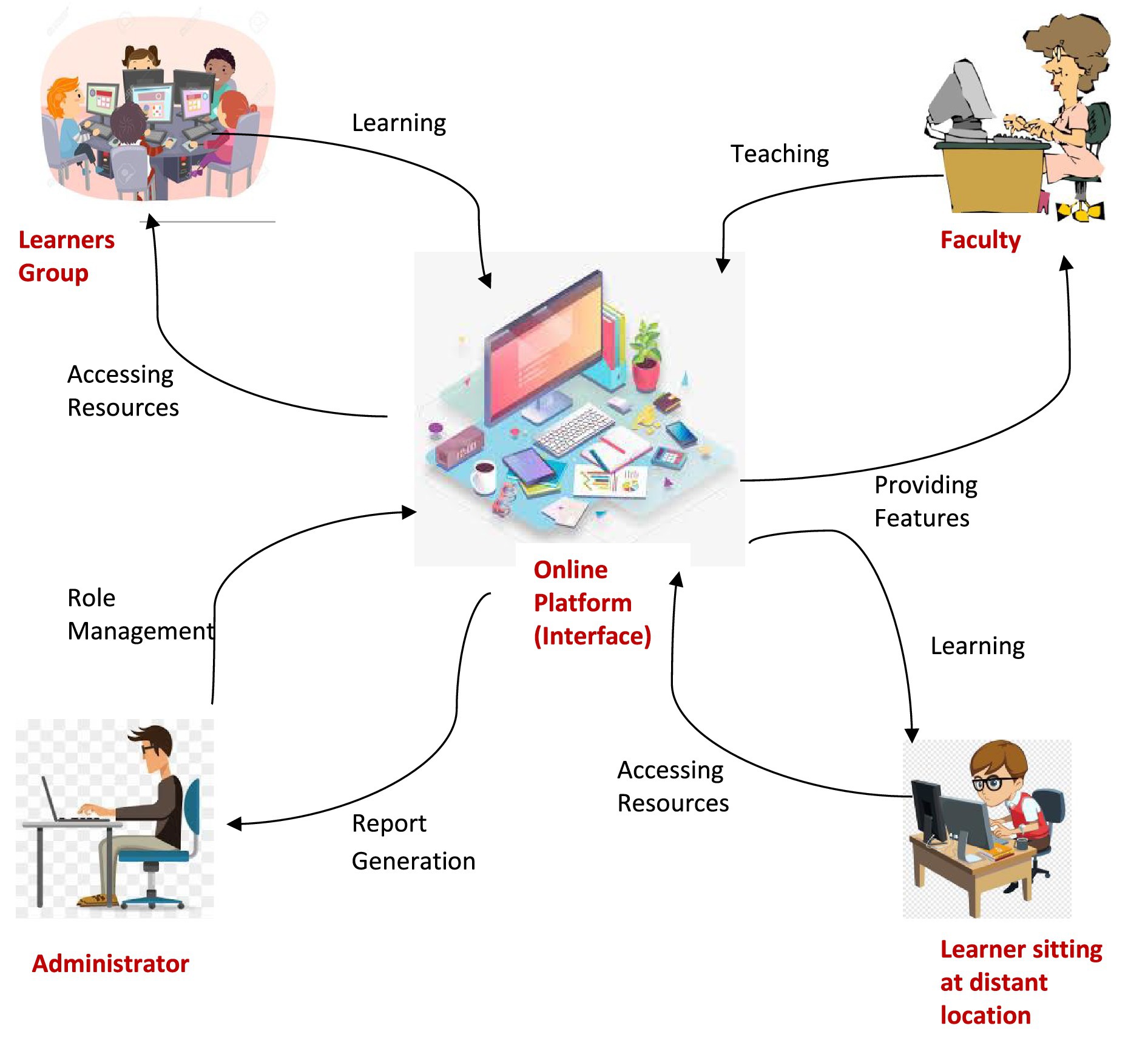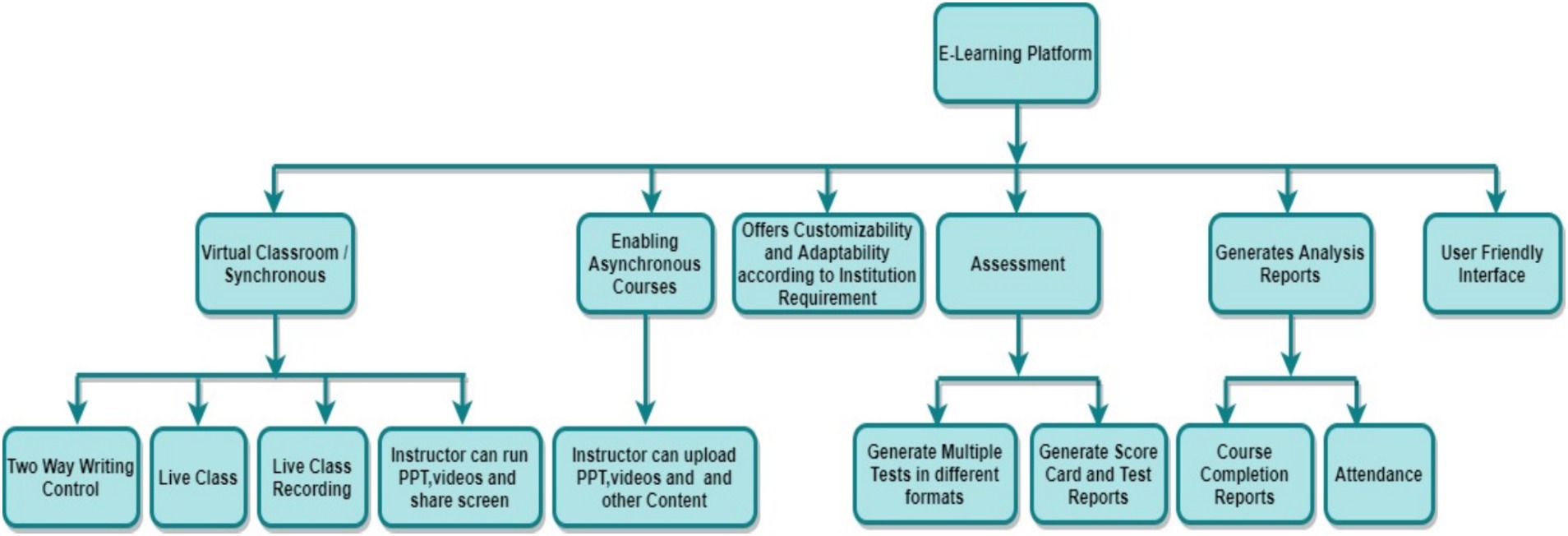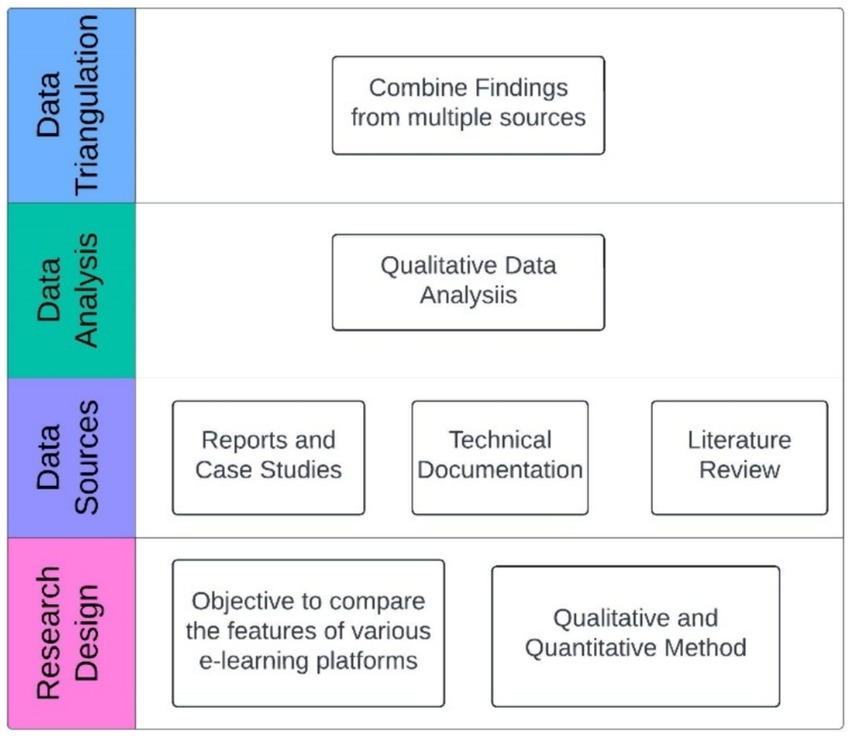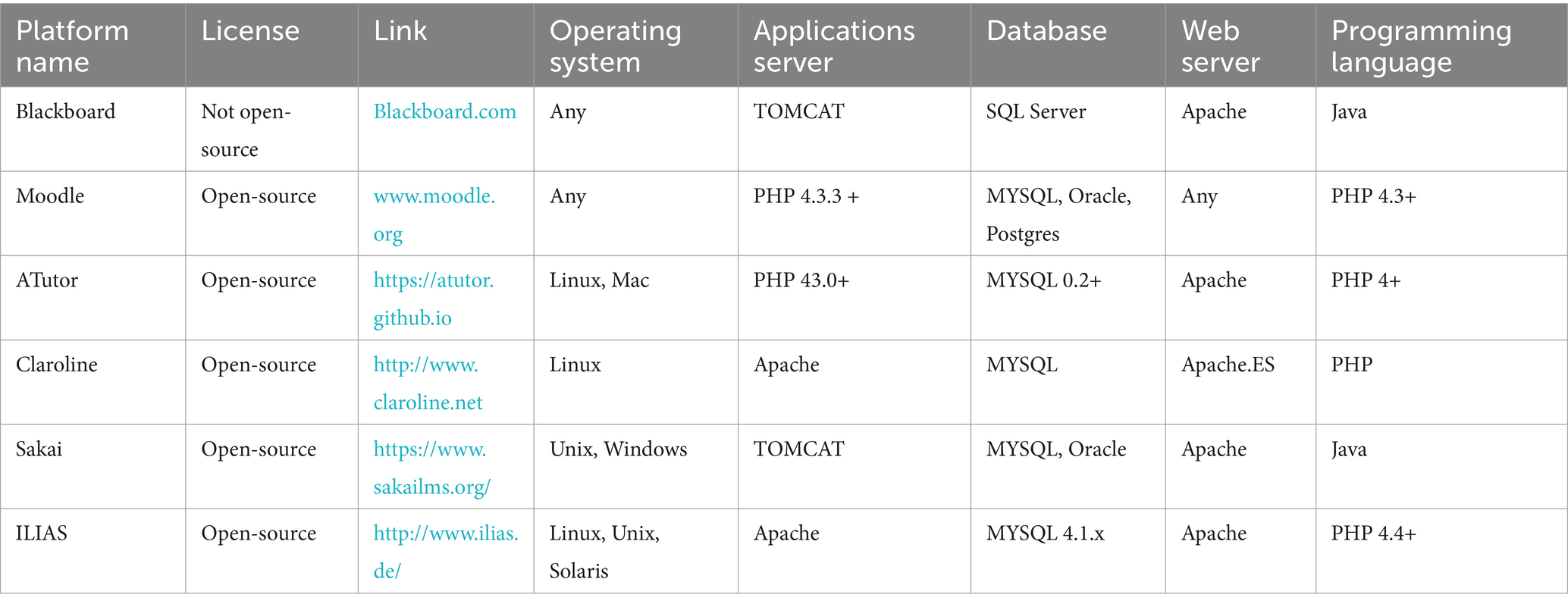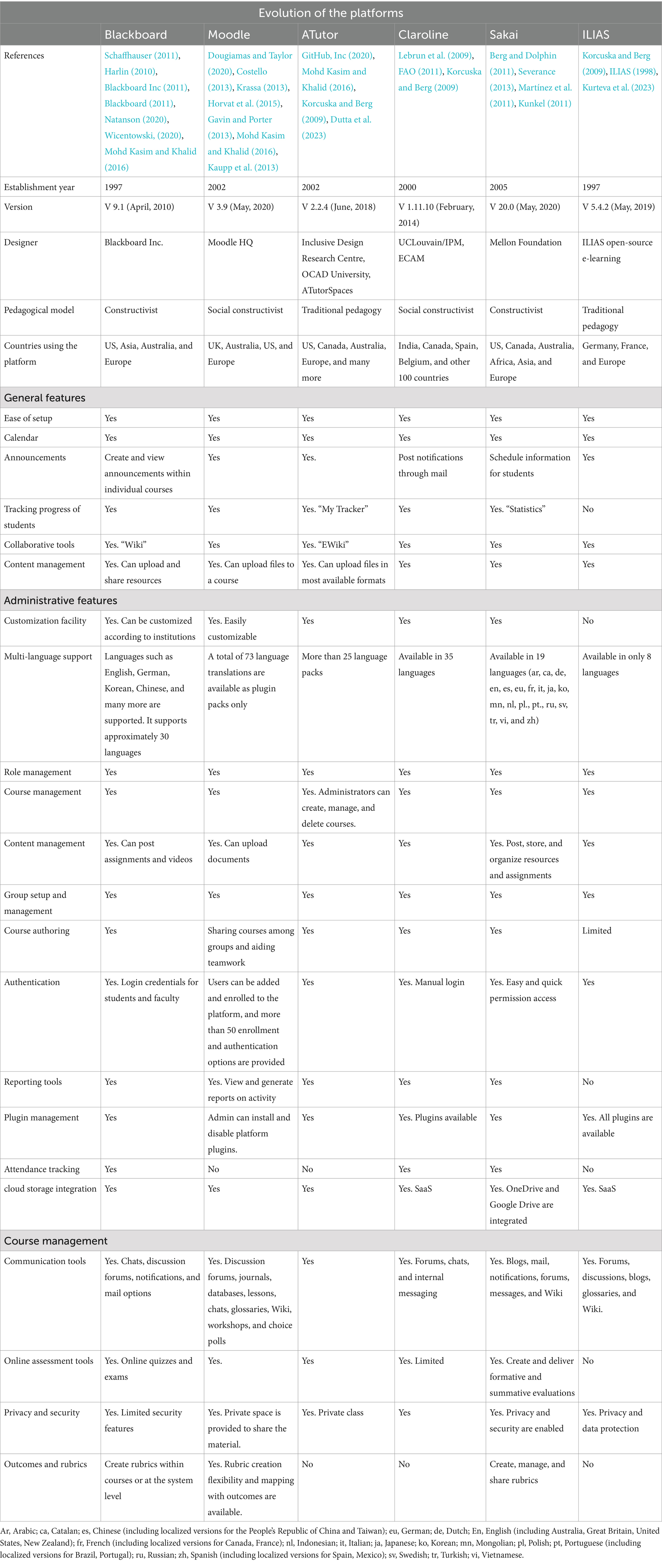- 1Chitkara University Institute of Engineering and Technology, Chitkara University, Punjab, India
- 2School of CS & AI, SR University, Warangal, Telangana, India
- 3Department of Electronics and Telecommunication, Symbiosis Institute of Technology (SIT), Symbiosis International (Deemed University) (SIU), Pune, Maharashtra, India
An online e-learning platform known as a learning management system (LMS) provides an interface between trainers, students, and administrators toward a common objective of learning. In the market, diverse LMSs with extensive functionalities are available to facilitate e-learning. In this article, we selected some popular LMSs majorly used by most schools and institutions for their teaching–learning process. We compared these LMSs in a discussion based on their technical specifications, technical features, administrative features, general features, and course management-related features. This comparative analysis could help users decide which LMS suits them best, according to their requirements. We also attempted to identify the limitations of these learning management systems so that users and organizations can determine which one is best suited to their needs.
1 Introduction
E-learning or virtual learning is accomplished through the means of computers/laptops connected to the Internet. The instructor in this mode of learning sits remotely and connects with learners through an online platform. It is a new form of learning that overcomes the limitations of geographical distance. A traditional or conventional learning methods require a teacher to take the class face-to-face with students in a closed classroom environment. Authors of a previous study (Oblinger and Hawkins, 2005) defined e-learning as the use of technology to deliver a complete course or part of it independently without the limitations of time and place. In addition, in 2001, the European Commission defined e-learning as the integration of the Internet and multimedia technologies to create easily accessible learning facilities. Any method of learning conducted through electronic means or digital technologies is called e-learning (Chawla et al., 2024). Keller et al. in 2002 refined the above definition by stating that learning that is web-based or Internet-enabled is termed e-learning (LaRose et al., 1998; Liaw and Huang, 2003). Liu and Wang (2009) defined e-learning on the basis of its characteristics. According to the authors, e-learning is a multimedia environment that incorporates several kinds of information collaboratively and the hardware only needs a network for the Internet, as it is independent of an operating system (OS). In Gotschall (2000), Liu and Wang reviewed the definition of e-learning through its features. Distance learning, sometimes used as a synonym for e-learning, is the transmission of lectures either through videos or live sessions (Ally, 2004). Different terminologies have been used by various authors to define e-learning (Ajayi, 2008; Ouadoud et al., 2016).
The various components of e-learning are teachers, participants, platform, course design, and the Internet for connectivity. Hence, e-learning can be considered the latest form of distance learning enabled by the Internet and the World Wide Web. Apart from being an online training or a computer-based training model, it has been proven to be an exceptional medium for the dissemination of knowledge and provides performance support through electronic means. The essential characteristic that makes e-learning more appealing and expedient when compared with conventional distance learning paradigms is the interactive feature, which dispels all prevailing myths surrounding these educational models. E-learning programs, although virtual, still hold the potential to ignite interest by offering interactive features such as online conferences, group communications, and discussion chat platforms.
1.1 Online platform
An online and e-learning platform is a type of software that assists an instructor in communicating with students during the online lectures of their courses. The e-learning platform uses a computing device that collaborates with numerous other tools to meet educational objectives (Dimet, 2006). Figure 1 shows the current model of an e-learning platform used nowadays. In this model, a particular course is delivered using an online platform as an interface between the teacher and the students. In the last few decades, e-learning platforms have changed a lot. Many authors have compared different online platforms in Menasri (2004); Dogbe-Semanou et al. (2007), and Rana et al. (2014), but these comparisons are no longer relevant as the platforms have evolved a lot with time. Detailed study conducted, results in listing down different features that must be part of an ideal e-learning platform, as shown in Figure 2. The main features that an online platform must include are as follows: a user-friendly environment, provision of both synchronous (live sessions) and asynchronous (uploading all resources so that students can learn at their own pace) modes of learning, customizability, facilities for assessments, and the capability for generating and analyzing results. All study materials are uploaded to the cloud using the Internet; hence, learners can access the uploaded data anytime and anywhere throughout the world (Reyes et al., 2007; Islam et al., 2015).
2 Methodology
The authors used the methodology shown in Figure 3. The methodology was divided into four major steps: research design, data sources, data analysis, and finally, data triangulation. First, the research objective was to compare the features of various e-learning platforms, and then, the decision regarding the quantitative and qualitative methods was made. Data for the analysis were collected from various reports, case studies, technical documentation of platforms available on the official websites, and an extensive literature review. After collecting the data, a quantitative data analysis was carried out, and the combined findings are tabulated in Tables 1 and 2.
3 Comparison of online platforms
Currently, a wide variety of online platforms are available in the market. Table 1 shows the most widely used online platforms mentioned by some authors (Kaware, 2015; Quadoud and Eddine, 2016; Cavus and Zabadi, 2014; Saeed, 2013; Pappas, 2015). E-learning platforms have now become a necessity in both secondary and higher education due to their various advantages, such as accessibility at anytime and anywhere, flexibility, and personalized learning experiences. These platforms, such as Moodle and Blackboard, can support a hybrid mode and increase student motivation (Schaffhauser, 2011). Other platforms, such as Coursera, Udemy, and Khan Academy, offer different features for self-paced learning and different pricing models to cater to diverse learning needs (Kurteva et al., 2023). When comparing e-learning platforms, factors such as navigability, scalability, applicability, accessibility, security, privacy, instructional structure, and interactivity are crucial (Ahmad and Härdle, 2008). As e-learning continues to grow, it is essential to assess its effectiveness in improving the quality of education and the self-study abilities of students. We chose only six platforms as they are preferred and widely used by the majority of universities (Schaffhauser, 2011). The various e-learning platforms were selected based on their technical specifications, popularity among educational institutions, and the availability of key features relevant to online learning. This analysis included a review of both open-source and proprietary platforms, considering factors such as user interface, accessibility, and administrative tools. The data collection is tabulated in Tables 1 and 2 for this research, which was carried out through a detailed comparison and evaluation of various e-learning platforms. Specific attention was given to the features that support synchronous and asynchronous learning, as well as to assessment and reporting tools. The data were collected from multiple sources, including previous comparative studies and technical documentation records of the platforms.
The overview of the information provided in Tables 1 and 2 is as follows:
General features:
• Ease of Setup: all platforms in the discussion are easy to set up, with simple installation and customization options.
• Tracking Student Progress: all platforms have robust tracking tools for monitoring progress. However, only Sakai and ILIAS have limitations or lack tracking tools.
• Content and Collaboration Tools: almost all platforms mentioned in the discussion section provide content uploading options and collaboration with Wiki-like tools.
Administrative features:
• Customization: Blackboard and Moodle offer extensive customization to meet the specific needs of institutions. Sakai, while flexible, has fewer customization features compared to others, and ILIAS does not have any customization.
• Multi-language Support: Moodle leads with 73 language options, while other platforms also support a broad range of languages, offering global accessibility. ILIAS provides the least support, with only eight languages.
• Role Management and Reporting: All platforms offer role management, allowing institutions to assign roles such as student, instructor, and admin.
Course Management (Content and Group Management): All platforms facilitate the easy upload of course materials and management of groups. However, only ILIAS has limitations in course authoring and advanced group collaboration.
• Communication and Assessment Tools: Blackboard and Moodle offer advanced communication tools (forums and chats) and extensive assessment features such as quizzes and online exams. In contrast, ILIAS and Sakai have basic or limited tools.
Privacy and security
• Blackboard has limited security features, which is its only drawback. Other platforms offer strong security features, including privacy controls and data protection, which make them a reliable tool for institutions handling sensitive information.
Cloud integration and plugin management:
• Many platforms integrate cloud storage (Google Drive and OneDrive) and allow flexible plugin management.
The incident that happened in spring 2020 during the coronavirus pandemic deserves special attention. The Fairfax County Public Schools, a renowned school division and the largest chain of schools in the United States, with an enrollment of 189,000 students, were using Blackboard. The students faced challenges such as hacking of live instructions due to security issues and slow connectivity, which made it difficult for them to connect to the system (Natanson, 2020). Based on the discussion in Tables 1 and 2, it is clear that almost all e-learning platforms comprised of all general features, except for Sakai, which lacks the feature of tracking student progression on the e-learning platform. Administrative features such as the customization of a tool according to customer requirements, course, content, and the role of user management are present in all platforms. Sakai lacks the feature of customization, which leads to difficulty in the operational flow of institutes. The most important feature of any learning management system (LMS) is related to its course delivery features. Communication tools in the form of chat windows, forums, and online assessment tools, along with rubric creation, privacy, and security, are the most important features of an LMS. In addition, Sakai lacks online assessment tools and rubric creation. ATutor and Claroline have online assessment tools, but they lack rubric creation. Based on the different features discussed, one could easily determine which LMS is preferable according to institutional requirements.
4 Conclusion
The use of e-learning platforms in educational approaches, especially in the era of the coronavirus pandemic, has increased significantly. Although we understand that there is no replacement for classroom teaching, e-learning platforms have become indispensable. In this context, an experiment is required to validate what has been summarized in this article. The experiment should incorporate the findings of a well-detailed comparative and evaluative study of the analyzed platforms and many other platforms. This will help us present our findings in the form of a recommendation system for e-learning platforms, which we envision to implement to assist in choosing the best-suited e-learning platform according to institutional objectives and specifications. This article emphasizes the importance of selecting the right Learning Management System (LMS) according to institutional requirements, especially in the context of increased e-learning adoption post-pandemic. In addition, this article proposes further experiments for developing a recommendation system that simplifies the selection process according to institutional needs.
Author contributions
SJ: Writing – original draft, Writing – review & editing. CP: Conceptualization, Writing – original draft, Writing – review & editing. DN: Formal analysis, Methodology, Supervision, Validation, Writing – original draft, Writing – review & editing. SB: Writing – review & editing.
Funding
The author(s) declare that no financial support was received for the research, authorship, and/or publication of this article.
Conflict of interest
The authors declare that the research was conducted in the absence of any commercial or financial relationships that could be construed as a potential conflict of interest.
Publisher’s note
All claims expressed in this article are solely those of the authors and do not necessarily represent those of their affiliated organizations, or those of the publisher, the editors and the reviewers. Any product that may be evaluated in this article, or claim that may be made by its manufacturer, is not guaranteed or endorsed by the publisher.
References
Ahmad, T., and Härdle, W. K. (2008). Statistics E-learning platforms evaluation: case study. SSRN Electron. J. doi: 10.2139/ssrn.2894279
Ajayi, I. A. (2008). Towards effective use of information and communication technology for teaching in nigerian colleges of education. Asian J. Inf. Technol. 7, 210–214.
Ally, M. (2004). “Foundations of educational theory for online learning” in Theory and practice of online learning. eds. T. Anderson and F. Elloumi (Athabasca, Alberta, Canada: Athabasca University & Creative Commons), 3–31.
Berg, A., and Dolphin, I. (2011). Sakai CLE Courseware Management: The Official Guide. (1st ed.). Edn. Birmingham, United Kingdom: Packt Publishing, 456.
Blackboard . "Getting to know Blackboard Learn". (2011). United States: Blackboard Inc. Available at: https://www.blackboard.com/Platforms/Learn/Products/Blackboard-Learn/Teaching-and-Learning/New-to-Learn.aspx
Blackboard Inc (2011). (BBBB) upgraded by Zacks investment research to "neutral" : American Banking News.
Cavus, N., and Zabadi, T. (2014). A comparison of open source learning management systems. Procedia. Soc. Behav. Sci. 143, 521–526. doi: 10.1016/j.sbspro.2014.07.430
Chawla, M., Panda, S. N., Khullar, V., Garg, K. D., and Angurala, M. (2024). Deep learning based next word prediction aided assistive gaming technology for people with limited vocabulary. Entertain. Comput. 50:100661. doi: 10.1016/j.entcom.2024.100661
Costello, E. (2013). Opening up to open source: looking at how Moodle was adopted in higher education. Open Learn. 28, 187–200. doi: 10.1080/02680513.2013.856289
Dimet, B. , “Etude comparative technique et pédagogique des platesformes pour la formation ouverte et à distance,” (2006). Available at: http://www.portices.fr/formation/Res/-Formation/Plateformes/Pf1Resume.html. Accessed on 06-Jun-2016.
Dogbe-Semanou, D. A. K., Durand, A., and Leproust, M. (2007). Etude comparative de plates-formes de formation à distance. lecadre du Projet@ 2L Octobre. 85–90.
Dougiamas, M., and Taylor, P. C. (2020). "Moodle: Using Learning Communities to Create an Open Source Course Management System. Australia: National Key Centre for Science and Mathematics Education Curtin University of Technology.
Dutta, R., Mantri, A., Singh, G., and Singh, N. P. (2023). Measuring the impact of augmented reality in flipped learning mode on critical thinking, learning motivation, and knowledge of engineering students. J. Sci. Educ. Technol. 32, 912–930. doi: 10.1007/s10956-023-10051-2
Porter, G. W. (2013). "Free choice of learning management systems: Do student habits override inherent system quality?". Inter. Tech. Smart ed. 10, 84–94. doi: 10.1108/ITSE-07-2012-0019
GitHub, Inc . "ATutor releases". Available at: https://github.com/atutor/ATutor/releases, (2020).
Gotschall, M. (2000). E-learning strategies for executive education and corporate training. Fortune 141, 5–59.
Harlin, K. (2010). Educational Software Maker Binds Students And Faculty. Investor's Business Daily. Washington, D.C: Blackboard Inc.
Horvat, A., Dobrota, M., Krsmanovic, M., and Cudanov, M. (2015). Student perception of Moodle learning management system: a satisfaction and significance analysis. Interact. Learn. Environ. 23, 515–527. doi: 10.1080/10494820.2013.788033
ILIAS . (1998). The open source learning management system. Available at: http://www.ilias.de/.
Islam, N., Beer, M., and Slack, F. (2015). E-learning challenges faced by academics in higher education: a literature review. J. Educ. Train. Stud. 3, 102–112. doi: 10.11114/jets.v3i5.947
Kaupp, James, Frank, Brian, and Watts, Christopher. Evaluation of software tools supporting outcomes-based continuous program improvement processes. Proceedings 2013 Canadian engineering education association (CEEA13) conference. (2013)
Kaware, S. S. (2015). Use of virtual classroom software for teaching. Scholar. Res J. Interdiscip. Stud. III/XVII, 3040–3047.
Korcuska, M., and Berg, A. M. (2009). Sakai Courseware Management: The Official Guide. (1st ed.). Edn. Birmingham, United Kingdom: Packt Publishing, 504.
Krassa, Anna (2013) Gamified Moodle Course in a Corporate Environment(PDF). 2nd Moodle research conference (MRC 2013). Sousse, Tunisia. pp. 84–93.
Kunkel, M. (2011). Das offizielle ILIAS 4-Praxisbuch: Gemeinsam online lernen, arbeiten und kommunizieren. 1. Auflage Edn. München: Addison-Wesley.
Kurteva, K., Tzanova, S., and Kurtev, N., “The impact of E-learning techniques on education process. Platform selection and comparison,” in 2023 XXXII international scientific conference electronics (ET), (2023).
LaRose, R., Gregg, J., and Eastin, M. (1998). Audio graphic tele-courses for the web: an experiment. J. Comp. Med. Commun. 4:JCMC423. doi: 10.1111/j.1083-6101.1998.tb00093.x
Lebrun, M., Docq, F., and Smidts, D. (2009). Claroline, an internet teaching and learning platform to Foster teachers’ professional development and improve teaching quality: first approaches. AACEJ 17, 347–362.
Liaw, S. S., and Huang, H. M. (2003). Exploring the world wide web for on-line learning: a perspective from Taiwan. Educ. Technol. 40, 27–32.
Liu, Y., and Wang, H. (2009). A comparative study on e-learning technologies and products: from the east to the west. Syst. Res. Behav. Sci. 26, 191–209. doi: 10.1002/sres.959
Martínez, R., David,, López, M., Raúl,, and Echeverría, M.Daniel (2011). Sakai. Administracion, configuracion y desarrollo de aplicaciones (1st ed.). Madrid, Spain: Ra-Ma Editorial, 238.
Menasri, S. , “Etude comparative de plateformes d’enseignement en ligne (e-learning) utilisées dans un contexte universitaire,” (2004). Available at: http://urfist.enc.sorbonne.fr/anciensite/archives/gremi/gremi10juin04/comparatif.htm#
Mohd Kasim, N. N., and Khalid, F. (2016). Choosing the right learning management system (LMS) for the higher education institution context: a systematic review. Int. J. Emerg. Technol. Learn. 11, 55–61. doi: 10.3991/ijet.v11i06.5644
Natanson, H. (2020). Tech glitches, harassment mar Fairfax County schools' online learning rollout. Washington Post. Available at: https://www.washingtonpost.com/local/education/fairfax-schools-online-harassment/2020/04/15/ (Accessed May 10, 2024).
Oblinger, D.G ., & Hawkins, B.L. , (2005). The myth about E-learning, Educause review, 40(4). Educause.
Ouadoud, Mohammed, Chkouri, Mohamed Yassin, Nejjari, Amel, and El Kadiri, Kamal Eddine. Studying and comparing the free E-learning platforms. ICTE: Information and Communication Technology for Education conference, (2016).
Pappas, Christopher . The Top Open Source Learning Management Systems [2019 Update]. (2015). Available at: https://elearningindustry.com/top-open-source-learning-management-systems
Quadoud, Amel Nejjari, and Eddine, Kamal. Studying and comparing the free e learning platforms. International conference ICTE: Information and communication technology for education. pp. 581–586, (2016).
Rana, H., Rajiv, P., and Lal, M. (2014). Role of artificial intelligence based technologies in e-learning. London: United Kingdom.
Reyes, Nicolus Ruiz, Sebastian, Pedro, and Raquel,. Comparing open source e-learning platforms from adaptivity point of view. The third advanced international conference on telecommunications, IEEE, AICT, (2007).
Saeed, F. A. (2013). Comparing and evaluating open source E-learning platforms. Int. J. Soft Comput. Eng. 3, 2231–2307.
Schaffhauser, Dian (2011). "Skidmore College Moves to Blackboard 9.1". Campus technology. Available at: https://campustechnology.com/articles/2011/03/02/skidmore-college-moves-to-blackboard-9.1.aspx.
Severance, C. R. (2013). Sakai: Building an Open Source Community. 2nd Edn. South Carolina, USA: CreateSpace Independent Publishing Platform, 235.
Keywords: e-learning, online platform, LMS, specifications, features
Citation: Jain S, Prabha C, Nandan D and Bhosale S (2024) Comparative analysis of frequently used e-learning platforms. Front. Educ. 9:1431531. doi: 10.3389/feduc.2024.1431531
Edited by:
Alba García Barrera, Universidad a Distancia de Madrid, SpainReviewed by:
Gül Kadan, Cankiri Karatekin University, TürkiyeCopyright © 2024 Jain, Prabha, Nandan and Bhosale. This is an open-access article distributed under the terms of the Creative Commons Attribution License (CC BY). The use, distribution or reproduction in other forums is permitted, provided the original author(s) and the copyright owner(s) are credited and that the original publication in this journal is cited, in accordance with accepted academic practice. No use, distribution or reproduction is permitted which does not comply with these terms.
*Correspondence: Chander Prabha, cHJhYmhhbmljZUBnbWFpbC5jb20=; Durgesh Nandan, ZHVyZ2VzaG5hbmRhbm81MUBnbWFpbC5jb20=; Snehal Bhosale, c25laGFsLmJob3NhbGVAc2l0cHVuZS5lZHUuaW4=
 Shaily Jain1
Shaily Jain1 Chander Prabha
Chander Prabha Durgesh Nandan
Durgesh Nandan